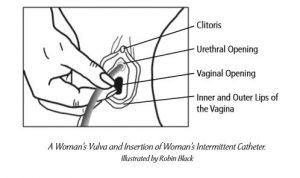
Question to Trudy
I want to point two things out to you. Neither a mirror or holding the labia apart really helps a women use an Intermittent Catheter.
Our body is built to work with us, not against us. This is why in all cultures, women squat to pee. On the toilet we squat, too. If you don't hold your labia to pee then you will not need to hold your labia when you cath. When we sit on the toilet and spread our legs the labia naturally opens. When you see pictures of women needing to hold their labia while inserting an intermittent catheter I guarantee you that it was thought up by a person that has not thought it through. When you urinate, the flow of urine is unobstructed. I rest my case
The use of a mirror is unnecessary, truly. I wish women were not trained this way. Trust me, you can find parts of your body by touch. I am sure a male thought this up because the thought of never seeing ones private parts is incomprehensible to them.When you get ready to insert an intermittent catheter:
- Wash your hands really well.
- Sit on the toilet with your legs spread or squat if you do not have a toilet.
- As you put your catheter near your labia, put your ring finger near your your upper leg (by your labia). Use the same spot every time. In the beginning, this will act as a marker. (Your urethra is between your clitoris and your vaginal opening).
- Gently probe the area for your urethra. I use the same finger, my ring finger to guide the catheter to my urethra. (For me it is off to the side a bit because of stitches which were the result of the use of forceps during the birth of a ten-pound baby).
- Gently probe the area and insert the catheter.
- You will find it, I promise.
I understand that there is a lot of stress the first time few times you do this. It is hard. I used to sweat buckets the first few times. But, rest easy, it will become second nature. I also ended up being a bit sore, initially, because I probed a bit too hard, in the beginning.
Advanced Advice
If you sit in the same position on the toilet, the area around your urethral opening will be in the same place every time. Remember, if you end up going on a hike or need to use a porta-potty, the spot you need to find will be shifted; fear not, you will find it. That is why I suggest that after you get comfortable with the same old, position, shift yourself so you do not fret the first time you venture out.
TIP: When I am camping and do not have access to clean water, I pack condoms to put over my ring finger as a barrier, because they are sterile and my hands are not.
Botox
I also want to add a note about botox. Women with an overactive bladder find great relief with botox.
I am sorry that you are diagnosed with a underactive bladder (UAB), for even a short while. It is what I have as well, although I will probably always have UAB. The good news for you is that now you understand what is going on. There are many, not as lucky as we are who have a sluggish bladder and suffer symptoms, but do not know that their difficult symptoms stem from a broken bladder. You are one step ahead of them. You're proactive and taking care of your problem.
In the book I wrote with Julia Parker MS MILS there is so much more about catheters, including Foley Catheters that you might like to read. This sample below is offered as an encouragement to stay the course and embrace your new life with intermittent catheters.
From the book "Beyond Embarrassment"
Knowledge Nugget Advantages of Clean Intermittent Catheterization
Advantages of Clean Intermittent Catheterization
Sterile intermittent catheterization was developed in 1947, and, by 1966, a long- term study concluded that this method is state of the art in the management of Neurogenic Bladder. The advantages of clean intermittent catheterization (CIC), which is regarded as the most effective way to aid in bladder-emptying disorders, include a lower risk of urinary tract infections (UTI), urosepsis, and renal damage, besides providing autonomy and mobility. [8,9,10] Prior to the availability of sterile intermittent catheterization, renal failure was one of the most frequent causes of death in spinal-cord injury patients, besides the abnormal backflow of urine back up into the ureters from the bladder (vesico-ureteral reflux). (Pressure within the kidney itself can severely damage it and prevent normal function.) Because urethral catheters are the most frequent cause of UTIs in hospitalized patients, [11] it is important to adopt a system that reduces that risk. Sterile intermittent catheterization, when used long term, reduces renal scarring and bladder calculi (stones), [12] which are common in bladders containing stagnant urine.
Please keep in touch and let us know how you are doing!
References and Notes

